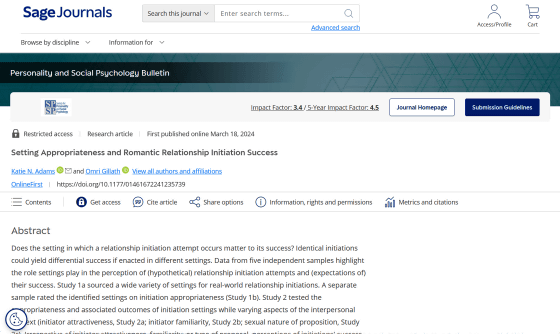Research shows that it is important to determine the 'location' when making a romantic approach

When approaching someone you're interested in, some people are picky about where they start the conversation, such as a 'stylish bar' or a 'restaurant with a beautiful night view.' In fact, a study conducted by a research team at
Setting Appropriateness and Romantic Relationship Initiation Success - Katie N. Adams, Omri Gillath, 2024
https://journals.sagepub.com/doi/10.1177/01461672241235739

Where you flirt matters: New research shows setting shapes romantic success
https://www.psypost.org/where-you-flirt-matters-new-research-shows-setting-shapes-romantic-success/
Previous research has shown that location influences judgments of someone's behavior, but there has been little systematic research on the importance of location in romantic approaches. Therefore, the research team investigated the places that people consider 'suitable for romantic approaches' and analyzed how they interact with other factors such as the other person's attractiveness, intimacy, and the content of the approach.
In their first exploratory study (Study 1a), the researchers asked 35 participants to list places they considered appropriate or inappropriate for romantic approaches. The results ranged from expected places like dating apps and bars to more unexpected places like grocery stores and public transportation. Based on these lists, the researchers narrowed down the locations to 48 different locations.
In a follow-up study (Study 1b), 162 subjects were shown the 48 locations listed in Study 1a and asked to rate them on a 5-point scale for their suitability for romantic approaches. Based on the results, the research team classified each location into three categories: 'high appropriateness,' 'medium appropriateness,' and 'low appropriateness.' High appropriateness locations included 'dating apps,' 'bars,' and 'private homes,' while medium appropriateness locations included 'gyms,' 'online gaming spaces,' and 'sidewalks,' while low appropriateness locations included 'workplaces,' 'clinics,' and 'funeral halls.'

The main experiment was divided into three parts (Study 2a, Study 2b, and Study 2c), and each experiment investigated how location suitability affects the probability of successful romantic approaches. In each experiment, participants were asked to imagine a hypothetical scenario in which they were approached by someone with a romantic interest at a selected location, and then rated how likely they were to accept the approach.
In Study 2a, we looked at the effect of the attractiveness of the approacher. Participants read scenarios in which they were approached by either an attractive or unattractive person in one of a variety of locations. The results showed that the attractiveness of the approacher did indeed increase the likelihood of accepting the approach, but the effect depended on the location. For example, participants were more likely to respond positively to an attractive person if they were approached in a highly appropriate location, such as a bar. However, if the approacher was in a less appropriate location, such as a doctor's office or a funeral hall, the advantage of attractiveness disappeared.
In Study 2b, we investigated the role of intimacy with the approacher. Participants read scenarios in which they were approached by either a close friend of the opposite sex or a stranger in various locations and responded to how they would respond. In general, intimacy had a small positive effect on the success of the approach, but close friends of the opposite sex were rated less favorably when the location of the approach was inappropriate. This result is likely due to participants' belief that 'a close friend could have chosen a better location.' Interestingly, women were less likely than men to respond positively to approaches from close friends of the opposite sex. This is probably due to gender differences in the perception of crossing friendship boundaries.
Study 2c investigated the effect of the approach itself on success. Participants read scenarios in which they received an invitation to dinner (a less sexually explicit approach) or an invitation to come to their house (a sexually explicit approach) in a variety of locations. Again, location was consistent and important, with both types of approaches being more successful when delivered in a more appropriate location.
A series of studies found significant interactions between location, type of approach, and subject gender. Women tended to prefer less sexual approaches in all locations and were more likely to reject sexual approaches in less appropriate locations. Men were also less likely to accept sexual approaches in inappropriate locations.

Across all three experiments, location appropriateness emerged as a consistent predictor of approach success, often stronger than other variables. Of course, attractiveness, familiarity, and approach content also influenced success rates, but none of these were able to overcome the effect of being in a socially inappropriate location.
However, limitations of this study include that it relies on a fictitious scenario and therefore does not fully reflect real-world behavior, and that participants were recruited primarily from American universities and the crowdsourcing platform Amazon Mechanical Turk, so results may not be the same for other populations or cultures.
'Future studies could address these limitations by using VR to simulate more realistic social environments or by conducting observational studies in real-world settings. They could also explore other aspects of the environment that may affect dating initiation, such as ambient noise, crowd density, or the presence of bystanders,' PsyPost said.
in Science, Free Member, Posted by log1h_ik